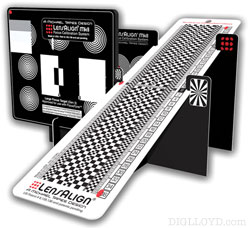Reader Question: Camera/Lens Focus Calibration
Eric B writes:

You are often testing new autofocus lenses, and often on the D810 DSLR. Do you focus tune these lenses before you shoot them and if not, why not.
I am now a mirrorless user but tried to focus tune my autofocus lenses when I used my D800E. I found it challenging to say the least. I’d appreciate hearing your comments about focus tuning and how you choose to focus manual focus lenses when you test those.
DIGLLOYD: See the lens align articles I’ve written over the years. Michael Tapes LensAlign Tool comes in various flavors from about $125 to about $85. If you’re going to focus tune your camera, it’s the best tool I know of.
I do not focus calibrate my lenses for two reasons: (1) I have had little trouble, and (2) I cannot present work on sharpness assuming that autofocus worked optimally: even very small errors would invalidate conclusions and gyrate areas away from the point of focus into total confusion as to peak performance (think field curvature and focus shift, which vary across the frame).
Therefore I do all my focusing in magnified Live View anytime I am evaluating image sharpness or making a comparison. Anyone relying on autofocus when assessing lens sharpness is incompetent, unless the goal is to assess sharpness of the system as a whole (what one gets on average using AF with any given lens, which often leaves out the lighting and subject matter thus making it even more lacking in rigor). Given variations in cameras and lenses and thus AF errors, nothing else has any rigor at all. I assess the peak optical quality, and that is hard enough to get right even in magnified Live View.
Alignment, precision and accuracy
To understand alignment, one must understand the what precision and accuracy mean, along with the damage from to sharpness from focus shift and that’s for starters.
If a camera does not compensate for focus shift and a lens has significant focus shift, then autofocus is hopeless for optimal results, since compensation is for only one aperture. So I’m going to ignore that here—just know it can be a huge factor for lenses with focus shift.
My understanding is that the D810 and recent cameras compensate for focus shift (D800/D800E I don’t know); see Nikon Appears to be Doing Focus Shift Compensation, at Least with the Nikon D810 and 70-200/2.8E.
DSLR autofocus uses a separate optical path for the AF system versus the optical path to the sensor. This is a key reason why alignment may be needed—those two paths are highly unlikely to be much better than 40 microns in agreement, which is the difference between tack-sharp and visibly unsharp. Worse, the AF sensors as seen by the user are generally coarse in size and not always where they are shown to be! Let’s set that whole can of worms aside too.
The key issues with fine focus calibration are accuracy and precision:
- Suppose the target is at 3 meters... if the camera always focuses at 2 meters half of the time and 4 meters half of the time, it is thus deadly accurate—and every picture will be blurred and useless. Accuracy is an average deviation from the true value.
- Precision is critical: think of it as how tight the grouping. Ten shots fired into the bullseye are highly precise and highly accurate (our ideal scenario). 10 shots hitting the target but randomly spaced over the target is not very precise but is highly accurate—and that is pretty much what DSLRs do a lot of the time (in near/far deviation from actual target distance).
If precision is high, then the grouping is tight and fine focus adjust feature can be used to re-center that grouping for high accuracy in a tight grouping. But my years of experience with DSLRs prove over and over that DSLR autofocus tends to not be precise at all, and precision is terrible for lenses with less than outstanding contrast (like most of Nikon’s f/1.4 lenses), particularly at medium-far distance. Hence fine focus adjustment is worthwhile, but it cannot address a fundamental failure—lack of precision. All it can do is center the loose (imprecise) grouping somewhat better. Lenses with very high micro contrast generally do much better, f/2.8 lenses do better than f/1.4 lenses, etc.
As for mirrorless, Sony has a serious bug in focusing stopped down. One can see the magnitude of the error by initiating AF at f/8, then opening up to full aperture—there can be a great deal of error, plenty enough to blur the image badly at full aperture. It is a fundamental problem with Sony, which is why when I use Sony AF, I never focus at f/8 or f/11 (one can usually get away with f/5.6 for an f/2.8 lens but it’s no guarantee of optimal). Trying to focus stack at f/8 or f/11 with Sony is a time-wasting annoyance since the lens has to be opened up for every frame in order to focus properly. It’s a particular nuisance for wide angles.
All these nuances have taken me years to nail down. See Making Sharp Images and/or hire me for a day on a photo tour and I can go through it all in the field with you.



























